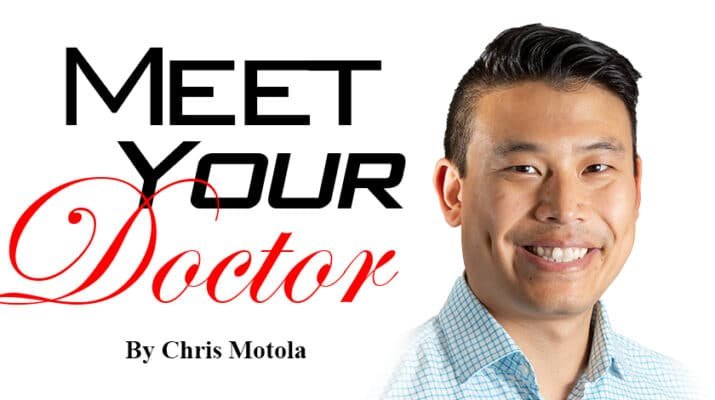Sports medicine doctor in Auburn: ‘We’re kind of like the primary care version of orthopedics’
By Chris Motola
Q: What are some of the misconceptions you think people have about sports medicine, what it is and who it’s for?
A: I’d say that probably, at this point, trying to decide who to see. Is your injury a sports injury? Do you need to see a shoulder or hand specialist? Sports medicine has kind of become a catchall. If you just have general knee pain, hip pain, elbow pain or shoulder pain, you’ll often start with sports medicine and then go from there. We’re kind of like the primary care version of orthopedics.
Q: What are the most common types of injuries you see?
A: Right now? Probably a mix of rotator cuff and meniscal injuries to the knee are most common.
Q: What kinds of activities tend to produce those injuries?
A: So in terms of sports-related activities, it would include a lot of overhead movements. Baseball, tennis, basketball, even golf, all put some low-level to high-level wear and tear on your shoulder. For the knee, especially around here during the winter months, it’s a lot of slip and falls. People are injuring their knees in day-to-day activities.
Q: Are you more specialized toward younger athletes or older active people?
A: The good thing about practicing sports medicine is you get to see a lot of different types of patients. A lot of the time I’ll see high schoolers up to around 23 year olds, but I do see patients younger than 10 and all the way up to active people in their 70s. It’s a whole wide range of age groups.
Q: How about acute injuries versus wear and tear?
A: A pretty good mix of both. This year I’ve seen a good mix of injuries from sports activities as well as patients who’ve had prior injuries in the past and are experiencing pain. Or patients who have had surgeries in the past who are experiencing pain or have re-injured themselves. There’s a good mix of both.
Q: For people in cold, Northern climates like ours, what would you recommend people do to avoid knee injuries?
A: Just take a look outside in the morning and make sure you know if there are any icy patches. Make sure you’re wearing the appropriate boots or snow shoes. For the elderly and geriatric patients, making sure they either have a cane or a walker when they go outside.
Q: How completely do people tend to heal from injuries? And how does sports medicine help with the healing process?
A: Being able to accurately diagnose the injury in the first place is important. This can give us an idea of whether we should prescribe physical therapy, when to prescribe injections or medication and when to recommend a surgical procedure. Getting the right diagnosis and treatment leads to better outcomes.
Q: Do you perform surgeries as well?
A: Yes, general orthopedic surgery, both sports- and injury-related.
Q: Does that include joint replacements?
A: Hip and knee replacements are usually done by my partner. I’m trained to do both, technically, but I don’t do the majority of our cases. I am trained to do shoulder replacement surgery, which is something I’d like to do more of now that I’ve started up here.
Q: COVID has a pretty big impact well outside of pathology. Have more injuries been going undiagnosed? Are patients deferring treatment?
A: Early on in the pandemic a lot of hospitals had to cancel elective surgeries, no exceptions. Luckily we’ve been able to continue even as a lot of hospitals are ramping down at the moment. So we’re lucky in that regard.
Q: What kinds of injuries should be seen immediately instead of just putting some ice on it and waiting and seeing?
A: I would say any injury around the knee where it feels like it’s unstable. Where it feels like if you walk around on it you might be in danger of falling. Those are symptoms you need to go and have checked out immediately. If you have an unstable knee and then you fall, you could end up with a much more serious injury. So knee injuries are something you want to take seriously.
Q: Is there any promising research coming down the pipeline with regard to healing persistent injuries?
A: It’s a field that’s always changing and adapting, but right now we still don’t have a magic bullet when it comes to treating cartilage injuries, especially in younger patients. So anything we can do to preserve cartilage and stabilize joints is always very important.
Q: What can be done to preserve cartilage?
A: Aside from just not getting injured? Steroid injections and medications can help with pain relief, but they won’t grow cartilage back. There are multiple types of procedures that can be done to restore cartilage, but again no one procedure is the gold standard in our field yet.
Lifelines
Name: Christopher Wang, DO
Position: Sports medicine, orthopedics and orthopedic surgery specialist with Auburn Orthopaedic Specialists
Hometown: San Diego
Education: Nova Southeastern University College of Osteopathic Medicine
Affiliations: Auburn Community Hospital
Organizations: American Orthopedic Society for Sports Medicine; American Osteopathic Academy of Orthopedics.
Family: Wife
Hobbies: Hiking, skiing, snowboarding
In the News
Physician Christopher Wang recently joined the orthopedic team at Auburn Community Hospital and will focus on sports medicine. He specializes in injuries to the shoulder, knee and hip as well as general orthopedics. He focuses on techniques that include minimally invasive arthroscopic procedures of the shoulder, knee and hip. Wang has worked with the Pittsburgh Pirates and USA Rugby as well as the Pittsburgh Riverhounds a USL (United Soccer League) national soccer club, and has extensive experience working with high school athletes.

